Minamoto no Yoritomo's establishment of the Kamakura government
Minamoto no Yoritomo (源頼朝, 1147-99) gained victory over the Taira (平) and established the first military government in Kamakura, which is also called Kamakura bakufu (1185/92-1333), Kamakura shogunate. The exact year of the start of this period is still contested, but major suggestions are:- 1180: Yoritomo first enters Kamakura and establishes his base here.
- 1185: Yoritomo's forces, under the command of Minamoto no Yoshitsune (源義経, 1159-89), finally defeat the Taira and he gains control of the country.
- 1192: Yoritomo is given the title of seii tai shogun (征夷大将軍) by Emperor Go-Toba (後鳥羽天皇, 1180-1239).
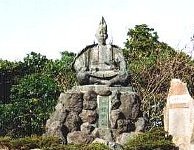
|
| Statue of Minamoto no Yoritomo |
In 1192, Yoritomo became seii-tai-shogun (征夷大将軍), a title that translates literally as "barbarian-subduing generalissimo." As such, one of his important tasks was to construct the city. He moved Yui Wakamiya Srine from present-day Zaimokuza (材木座) to its present site, setting up as Tsurugaoka Hachimangu Snrine.
The first of the government offices located at Okura (大蔵) was the Samurai-dokoro (侍所), Board of Retainers, set up in 1180 to discipline and control the vassals. In 1184, next came the Kumonjo (公問所), Public Documents Office. Later in 1191 the Mandokoro (政所), Administrative Board, was established, which absorbed the Kumonjo, to deal with general government matters, finance, and management of the city of Kamakura. A third office, also in 1184, was the Monchujo (問注所), Board of Inquiry, to hear and review claims and law suits.
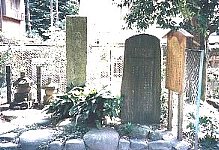
|
| Former site of Shochojuin Temple |
Feud between two brothers: Yoritomo and Yoshitsune
In the course of stabilizing his government, however, the long-simmering feud between minamoto no Yoritomo (源頼朝) and his younger brother, Yoshitsune (義経), finally erupted. Yoshitsune was manipulated by the retired Emperor Go-Shirakawa (後白河, 1127-92) who was highly displeased with the military government for having become too powerful, Yoshitsune accepted a high position at court without first notifying Yoritomo in Kamakura. Such acceptance of high rank in court posed a danger to the newly-formed Kamakura government, because Yoritomo's first priority was unity created under his own command.After Yoshitsune destroyed the Taira in 1185, he tried to return to Kamakura and plead his innocence, but was blocked at Koshigoe (腰越). Yoshitsune then submitted a series of oaths stating his complete loyalty to Yoritomo, but on the advice of Kajiwara Kagetoki (梶原景時, ?-1200), all were disregarded. (Kagetoki's statements were taken as slander by many influential vassals who were sympathetic to Yoshitsune, and Kagetoki was later year ousted from the government). Yoshitsune sent a letter to Oe no Hiromoto (大江広元, 1148-1225) while he was staying in Koshigoe, a letter that was to be his last message and is now referred to as Koshigoe-jo (腰越状), the Letter of Koshigoe.
With all of his pleas now rejected, Yoshitsune was forced to return to Kyoto. Backed into a corner, he then received a decree from the retired Emperor Go-Shirakawa to conquer Yoritomo and rose against him in 1185. Yoritomo, in response, dispatched a large army to Kyoto, and Yoshitsune was forced to flee yet again. But before he arrived in Hiraizumi (平泉, in present-day Iwate Prefecture, 岩手県), he had to part from Shizuka Gozen (静御前, ?-?), his mistress. She had followed him but was captured at Mt. Yoshino (吉野山) in Nara Prefecture (奈良県) and sent to Kamakura.
There, within the grounds of Hachimangu Shrine, in the presence of Yoritomo and his wife Masako (政子), Shizuka bravely performed a dance, defiantly singing a song expressing her love for Yoshitsune. Later, Yoshitsune took refuge with the Fujiwara family (藤原一族) in Hiraizumi. This did not mean safety, however. In 1189 he and his followers were attacked and killed there by Fujiwara no Yasuhira (藤原泰衡, 1155-89), who had been pressured by Yoritomo to carry out this act.
Second shogun: Minamoto no Yoriie
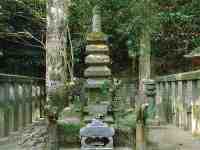
|
| Tomb of Minamoto no Yoritomo |
Yoriie is said to have had an unstable character and was rendered powerless by his mother, Masako, and the Hojo family. They formed a council of senior officials at the head of the shogunal government, including Hojo Tokimasa (北條時政, 1138-1215), his son Hojo Yoshitoki (北条義時, 1163-1224), Oe no Hiromoto and Miyoshi Yasunobu (三好康信, 1140-1221).
When Yoriie became seriously ill in 1203, the council decided to divide the shogunal land-rights between his son Ichiman (ー幡, 1198-1203) and his younger brother, Minamoto no Sanetomo (源実朝, 1192-1219) without even consulting Yoriie. Offended by the decision, Yoriie plotted against the Hojo, gaining support from his father-in-law, Hiki Yoshikazu (比企能員, ?-1203). The Hojo, however, forestalled Yoshikazu. On a pretext, Hojo Tokimasa invited him to a Buddhist service where he was killed, and the Hiki were then wiped out by the Hojo at Hikigayatsu (比企が谷), where Myohonji Temple (妙本寺) now stands. The Hojo's scheme to do away with their rivals gradually succeeded. Yoriie was killed at Shuzenji Temple (修禅寺) in present-day Shizuoka Prefectuer (静岡県).
Third shogun: Minamoto no Sanetomo
After Yoriie, Minamoto no Sanetomo (源実朝, 1192-1219), Yoritomo's second son, assumed the title of third shogun in 1203 at the age of thirteen. He is remembered in history more for his extraordinary talent in literature than for any ability in politics. Resentful of his powerlessness under the constant watch of both his mother, Masako, and his uncle, Tokimasa, he is said to have indulged in the literary arts and the aristocratic game of kemari (蹴鞠), a kind of kickball.When he was only fourteen years old, he began to learn poetry under Fujiwara no Teika (藤原定家, 1162-1241), a famous court poet in Kyoto. An anthology of his works, Kinkai Wakashu (金槐和歌集), The Collection of the Kamakura Ministry of the Right, was compiled by Teika after Sanetomo's death. His poems are direct and powerful, quite in contrast to the refinement and elegance of the court poems of the day.
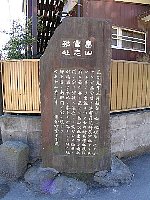
|
| Former site of Hatakeyama residence |
Hojo Yoshitoki succeeded his father Tokimasa as the second regent, shikken (執権). Next came a battle in 1213 between the Hojo and the Wada, referred to as the Wada Gassen (和田合戦). It originated as a trap laid by Yoshitoki, who hoped to eliminate his rival, the Wada clan. Wada Yoshimori (和田義盛, 1147-1213) and his family were powerful and fought bravely, but in the end were defeated and destroyed in 1213. Thus, Yoshitoki consolidated his position as second regent.
Sanetomo's unfulfilled dream and end of Yoritomo's direct lineage
In spite of these circumstances, Sanetomo had the impressive temple complex of Daijiji (大慈寺, now only memorial stone) in Juniso (十二所) built in 1212. Expanding his dreams further, Sanetomo ordered the construction of a ship large enough to sail to China. The ship, however, could not be floated due to the shallowness of the water at Yuigahama.At court, Sanetomo sought to rise from one high rank to another, and in 1218 finally attained the post of Udaijin (右大臣), Minister of the Right. His life, however, like that of his predecessor, Yoriie, was ill-fated. On a snowy evening sometime in January 1219, as Sanetomo was leaving the grounds of the Hachiman Shrine after attending a ceremony to express his gratitude for promotion to the position of Minister of the Right, he was set upon by his nephew Kugyo (公暁, 1200-19) and murdered. Kugyo, in turn, was killed soon after by order of Yoshitoki. Who exactly masterminded the entire affair, however, is still unknown.
Direct lineage from Yoritomo thus ended with the third succession. What the visitor here in Kamakura can now see is a memorial stone for the repose of Sanetomo's soul, along with one for his mother, Masako, at Jufukuji Temple (寿福寺).
Jokyu disturbance; Imperial rebellion
Masako soon became a nun and was known as the "Ama Shogun" (尼将軍), literally, Nun Shogun. She then had no choice but to adopt Fujiwara no Yoritsune (藤原頼経, 1218-56), who was only two years old and a remote relative of the Minamoto, as the fourth shogun. After that, one nominal shogun followed another: the fifth, Fujiwara no Yoritsugu (藤原頼嗣, 1239-56), the sixth, Munetaka Shinno (宗尊親王, 1242-74), the seventh, Koreyasuo (惟康王, 1264-1326), the eighth, Hisaaki Shinno (久明親王, 1276-1328), and the ninth, Morikuni Shinno (守邦親王, 1301-33). Most were powerless and under the complete control of the Hojo regents. Some were forced to retire, and some were even sent back to Kyoto.In 1221, in Kyoto the retired Emperor Go-Toba (後鳥羽法王, 1180-1239) and supporters of the imperial cause attempted to overthrow the Kamakura government. In response to this attempt, known as Jokyu no Ran (承久の乱), the Jokyu Disturbance, Masako and her son, Yoshitoki, united the vassals to fight against the court's forces, and within a month claimed victory. Masako had successfully evoked loyalty among the retainers, it is said, by reminding them of their immense obligations to Yoritomo.
The Kamakura government strengthened its guard against the court. Under Yoshitoki, it established the office of shogunal deputy, Rokuhara Tandai (六波羅探題), in Kyoto to keep an eye on the court and assigned Hojo Yasutoki (北条泰時, 1183-1242), the eldest son of Yoshitoki, to this post.
Consolidation under Hojo regency
Next, Yasutoki, upon the death of his father Yoshitoki in 1224, became the third shogunal regent. Under his leadership, the Kamakura government reached the height of its prosperity due to his success in introducing new measures that consolidated government power. In 1226, he established the Hyojoshu (評定衆), Council of State. Eleven (later fifteen) men from various clans participated in it, deciding important personnel, political and judicial matters. Its main purpose was to avoid the hitherto erroneous and dictatorial leadership of the Hojo family. In 1232, Yasutoki proclaimed the Kanto Goseibai Shikimoku (関東御成敗式目), the first codification of Warrior House Law, which consisted of 51 articles that spelled out the rights of the warrior class and clarified the duties and responsibilities of officials.Yasutoki also transferred the location of the bakufu twice: moving it first from Okura (大蔵), where Yoritomo had established it, to Utsunomiya-zushi (宇都宮辻子) close to the second torii of Hachimangu Shrine and named it Utsunomiya-zushi bakufu (宇都宮辻子幕府). In 1236 it was moved again to a neighboring site and renamed Wakamiya-oji bakufu (若宮大路幕府).
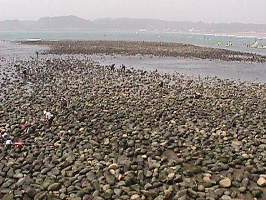
|
| Site of Wakaeno-shima Port, the oldest artficial harbor that remains today |
Hojo Tokiyori: Road to Hojo dictatorship
The fourth regent, Hojo Tsunetoki (北条経時, 1224-46), a grandson of Yasutoki, died young. The fifth regent was Hojo Tokiyori (北条時頼, 1227-63), younger brother of Tsunetoki. He became regent in 1246, and in the following year eliminated the Miura family, who had been powerful vassals from the time Yoritomo had established the government. Tokiyori replaced the shogun, Fujiwara no Yoritsugu, with Prince Munetaka (宗尊親王, 1242-74). From that time on, the seat of the Kamakura shogunate came to be occupied by a succession of princes from Kyoto.
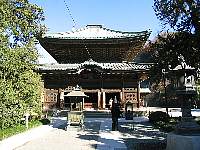
|
| Kenchoji Temple |
Hojo Tokimune and Mongol invasions
After Nagatoki came Masamura (政村, 1205-73), then Hojo Tokimune (北条時宗, 1251-84) who became the eighth shogunal regent in 1268. Tokimune twice faced Mongol invasions, once in 1274 and again in 1281. The first was launched because the Kamakura government had rejected the Mongol demand for submission. In response, Khubilai (or Kublai) Khan sent his forces to Hakozaki Bay (箱崎湾) near Hakata (博多) in northern Kyushu (九州). Fortunately, a storm did great damage to the invaders' ships, forcing them to retreat.An angered Khan later sent larger forces to Hakata Bay in 1281 because the Kamakura government not only again refused his demand for submission, but also beheaded his envoys. The government was driven into a corner in the face of the Khan's large forces, but again a typhoon arose and forced the Mongol fleet to retreat.
Victory at first seemed to produce a certain amount of national pride and to increase the prestige of the Hojo. Yet in reality the result was exactly the reverse. Since the war had been fought against foreign invaders, the government could not sufficiently reward its retainers for their sacrifices in the face of national emergency. Dissatisfaction prevailed among the retainers, damaging the popularity of the Hojo, and their power began to decline.
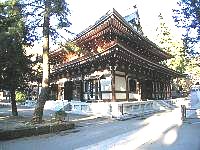
|
| Engakuji Temple |
Sketch of the town, Kamakura
After Minamoto no Yoritomo's establishmentIn October 1180, Yoritomo entered Kamakura with his followers. When he had his mansion built in Okura, his major retainers followed suit, their estates standing along the hillsides for defense against attacks from outside. Gradually merchants and manufacturers set their dwellings in the area near the sea to take advantage of sea transportation to Wakae-no-shima Port.
Four borders bounded Kamakura: Mutsura (六浦, the old pronunciation of Mutsuura), Kotsubo (小坪), Inamuragasaki (稲村が崎) and Yamanouchi (山ノ内) to the east, south, west and north, respectively. Inside these boundaries was the city itself.
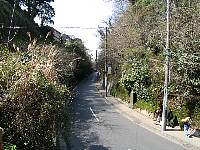 |
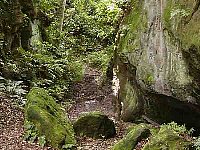 |
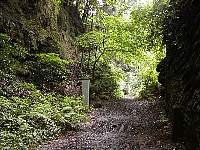 |
| Gokurakujizaka Pass | Daibutsuzaka Pass | Asahinakiridoshi Pass |
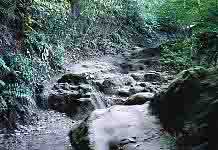
|
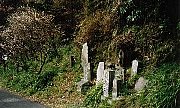
|
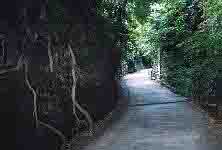
|
| Kewaizaka Pass |
(Former) Kobukurozaka Pass |
Kamegayatsuzaka Pass |
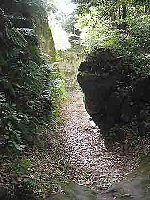 |
| Nagoe Pass |
People came and went via nana kuchi (七口), seven entrances, or nana kiridoshi (七切通し), seven passes. The former were Gokurakuji-kuchi (or -guchi) (極楽寺口), Daibutsuzaka-kuchi (大仏坂口), Kewaizaka-kuchi (仮粧 or 化粧坂口), Kobukurozaka-kuchi (巨福呂坂口), Mutsura-kuchi (corresponding to Asahina-kiridoshi), Nagoe-kuchi (名越口), and Kotsubo-kuchi. The seven passes included Kamegayatsu-zaka (亀ケ谷坂) in addition to the above-named entrances with the exception of Kotsubo-kuchi.
The more commercial activities increased, the more people flowed into Kamakura, bringing about prosperity but also disorder and confusion. In 1251 the government designated seven commercial districts: Omachi (大町); Komachi (小町); Komemachi (米町); the area around Kamegayatsu (亀ケ谷); the area of around Okura (大蔵); the area at the top of Kewaizaka (仮粧坂); and Wakae, where the government banned the tethering of cows on streets and ordered that the streets be kept clean.
In 1265, the bakufu designated seven licensed commercial areas: Omachi, Komachi, Komemachi, Okura, Musashi-oj-ishita (武蔵大路下) (in place of Kamegayatsu and Kewaizaka), Sujikaebashi (筋替橋) (in place of Wakae), and newly added Uomachi (or Iomachi) (魚町).
As the number of legal and illegal residents increased, Kamakura seemed on the verge of chaos. City control was under the jurisdiction of the Mandokoro.
In 1245, the bakufu prohibited the following acts: hunting with hawks within Kamakura; making a path without permission; extending walls towards streets; and extending one's house over the ditch in front of it.
In 1247, the bakufu road-checked wandering warriors, banishing them from Kamakura to maintain law and order.
In 1261, retainers were ordered to refrain from building luxurious homes and were encouraged to repair bridges in the city and sweep clean the streets in front of their own houses. Abandonment of children and corpses of the diseased was also prohibited.
Visitors' views of Kamakura
People from the western part of Japan viewed Kamakura favorably. The Kaidoki (海道記), the diary of a journey from Kyoto to Kamakura written in the 1220s, records that the sight of hundreds of boats at anchor here made it look like Otsu (大津) in Omi Province (近江, in present-day Shiga Prefecture, 滋賀県), and that the rows of thousands of houses resembled those of Oyodo (大淀) in Osaka. The diary further notes that Kamakura has the sea and hills, and is blessed with water and forests. The city was neither too big nor too small; streets were linked everywhere, and Kamakura was as prosperous as Kyoto.
Another travel diary, the Tokan Kiko (東関紀行) refers to the magnificence of such structures as the residence of the shogun, Yofukuji Temple, and Hachimangu Shrine, as well as the Great Buddha in Hase.
Life of the warrior class
The warriors' lives were dedicated to such martial arts as swordsmanship, archery, and horsemanship, which prepared them physically and mentally for any contingency their masters, especially the bakufu, might have to face. Loyalty, honor, bravery, and frugality were highly esteemed. In earlier times, when the warrior class was in its formative stage, it was through hunting that they first polished their military skills. Later, this practice turned into shooting at a target from the back of a running horse. Yabusame (流鏑馬), a kind of ceremonial archery on horseback, was first held in 1187 under the auspices of Yoritomo in the grounds of Hachimangu Shrine, and is even today continued as an important and popular annual festival event attracting many on-lookers.
Arms and swords were very important. Okazaki Masamune (岡崎正宗, late 13th to early 14th century), a skilled sword maker, lived in Ogigayatsu (扇ケ谷) and made heigh quality swords.
Warriors had simple meals twice a day, as did the common people. The mainstay was unpolished rice, accompanied by such items as pickled plums, dried jellyfish, beaten and salted abalone, as well as other seafood, venison, boar meat, certain kinds of birds, peaches, chestnuts, and walnuts. A typical meal served at a party along with unrefined sake included unpolished rice porridge with millet, jellyfish, Japanese ginger pickled in vinegar, cucumber rubbed with sake lee, grilled and salted sweetfish (ayu,鮎), boiled eggplant, chestnuts, dried persimmons, and a type of carp called funa (鮒).
Decline of the Kamakura government
After Tokimune, the post of regent was successively occupied by Hojo Sadatoki (北条貞時, 1271-1311, the ninth regent); Hojo Morotoki (北条師時, 1275?-1311, the tenth regent); Hojo Munenori (北条宗宣, 1259-1312, the eleventh regent); Hojo Hirotoki (北条煕時, 1279-1315, the twelfth regent); Hojo Mototoki (北条基時, ?-1333, the thirteenth regent); Hojo Takatoki (北条高時, 1303-33, the fourteenth regent); Hojo Sadaaki (北条貞顕, 1278-1333, the fifteenth regent) and the sixteenth and last regent, Akamatsu Moritoki (赤松守時, 1295-1333).During the rule of Sadatoki, the Adachi family (安達) was destroyed in 1285, which set the stage for the beginning of a dictatorship by the head of the Hojo clan. The patrimonial head of the main branch of the Hojo, called tokuso (得宗), held more power than did the regents.
Under the regency of Sadatoki, the bakufu issued a decree, Einin no Tokuseirei (永仁の徳政令), in 1297. It is thought to have been a well-meaning attempt on the part of the government to help retainers out of economic difficulties, but it did not work effectively.
Takatoki, after retiring from the regency, wielded substantial control of the bakufu as Tokuso. He was said to be responsible for the corruption of the regime, for he is reputed to have spent his time engaging in dancing, dogfights and other such diversions, leaving the affairs of state in the hands of his men. Given these circumstances, the court in Kyoto, which had been watching for a chance to regain power, took action and, succeeded in 1333.
Collapse of the Kamakura government
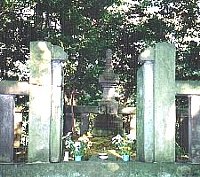 |
| Tomb of Hino Toshimoto |
The relationship between the court and the bakufu continued to deteriorate. Eventually, in 1331, Go-Daigo took up arms against Kamakura at Kasagi (笠置) in the southern part of Kyoto. The bakufu sent its army, headed by Ashikaga Takauji (足利高氏, later 尊氏, 1305-58) and defeated the emperor's forces. With the emperor arrested and exiled to Oki Island (隠岐島, in present-day Shimane Prefecture, 島根県) in 1332, the matter seemed to be settled. But, Emperor Go-Daigo was rescued from Oki Island by his supporters, and in 1333 the loyalist tide reached its peak.
Surprised at this turn of events, the bakufu again sent Takauji's army to Kyoto. This time, the ambitious Takauji knew which way the wind was blowing. Upon arrival in Kyoto he turned his back on the bakufu, and attacked and destroyed the Rokuhara Tandai (六波羅探題), the bakufu's deputies stationed at Rokuhara in Kyoto.
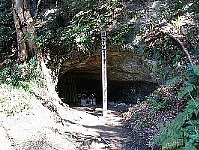 |
| Final resting place of the Hojo |